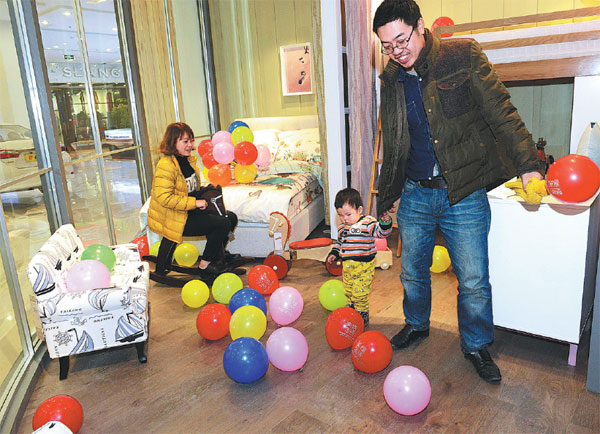Millennials' yen for a room of fine furniture
New homeowners eschew traditional aesthetics to go for more simplistic, lighter, western designs and brands from Japan
The preference of Chinese millennials for fine furniture has brought opportunities for interior designers and premium furniture brands, especially those coming from northern Europe.
As those born in the 1980s and 1990s get their hands on their first houses, the market has seen a seminal shift in taste. It has gone from predominantly traditional Chinese aesthetics - featuring heavy wooden furniture and dark-red floors made of expensive, sometime rare woods - to simplistic western styles.
Sugar Lee, a 29 Shanghai-based home design magazine editor, spent about nine months decorating her home with her partner. It cost the young couple about 270,000 yuan ($41,189) to do up their 46-square-meter pad.
|
A father plays with his child in a sample room of a furniture design company in Rizhao, Shandong province. Chen Weifeng / For China Daily |
Defining her home as a fusion of French and northern Europe styles, most of their furniture was bought in design shops in Shanghai, like Design Republic, Casa Casa and BoConcept. Cheaper pieces from Ikea can also be found in her home.
"The younger generation has undoubtedly developed different tastes," Lee said, "We are more international, influenced by all kinds of ideas from around the world."
Neil Wang, president of consultancy Frost and Sullivan Greater China, pointed out that such shift in taste was due to the different concepts and lives being pursued by Chinese youngsters compared to their parents.
"Simplistic interior designs from Japan and North Europe are more budget friendly. With the ever climbing prices of houses, youngsters don't have much money left for the luxury Chinese wooden furniture their elders preferred," Wang said.
"Take Ikea for example. Its prices and designs meet the needs of the younger generation, "Wang added.
He said their demographics meant they were always open to new experiences, which meant changing their furniture more often.
"Many young people rent homes and they are constantly on the move, so they want furniture which is more affordable and can be thrown away," Wang said.
"Also, their fast-paced work and lives places mental stress on the young and it also explains why they want to live in places with light, simple and clean designs," Wang added.
"It provides a sense of comfort, compared to the heavy and serious Chinese furniture."























